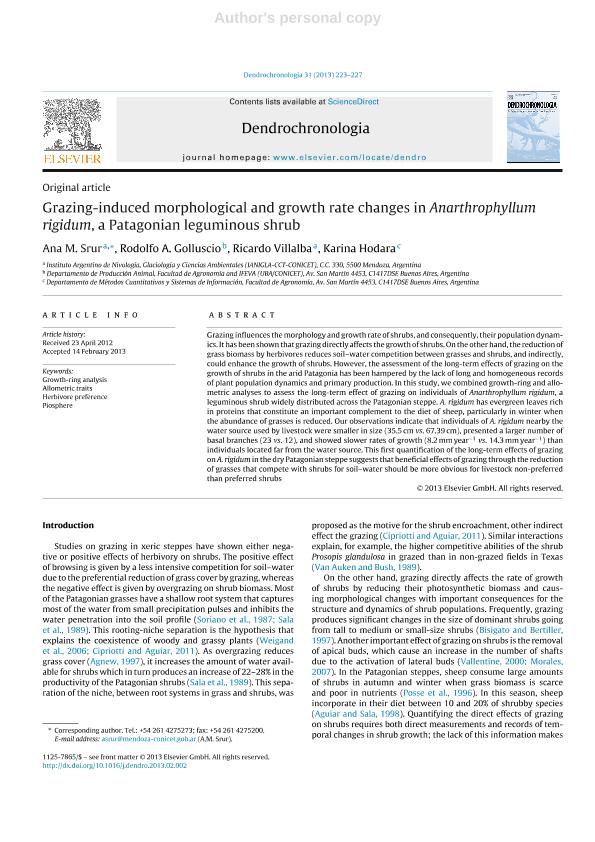Mostrar el registro sencillo del ítem
dc.contributor.author
Srur, Ana Marina

dc.contributor.author
Golluscio, Rodolfo

dc.contributor.author
Villalba, Ricardo

dc.contributor.author
Hodara, Karina
dc.date.available
2016-02-12T19:11:21Z
dc.date.issued
2013-04
dc.identifier.citation
Srur, Ana Marina; Golluscio, Rodolfo; Villalba, Ricardo; Hodara, Karina; Grazing-induced morphological and growth rate changes in Anarthrophyllum rigidum, a Patagonian leguminous shrub; Elsevier; Dendrochronologia; 31; 3; 4-2013; 223-227
dc.identifier.issn
1125-7865
dc.identifier.uri
http://hdl.handle.net/11336/4188
dc.description.abstract
Grazing influences the morphology and growth rate of shrubs, and consequently, their population dynamics. It has been shown that grazing directly affects the growth of shrubs. On the other hand, the reduction of grass biomass by herbivores reduces soil-water competition between grasses and shrubs, and indirectly, could enhance the growth of shrubs. However, the lack of long and homogeneous records of plant dynamics and primary production in the arid Patagonia hampers the assessment of the long-term effects of grazing on the growth of shrubs. We combined allometric and growth-ring analyses to assess the direct effect of grazing on individuals of Anarthrophyllum rigidum, a leguminous shrub widely distributed across the Patagonian steppe. The evergreen, protein-rich leaves of A. rigidum constitute an important complement for the sheep diet, particularly in winter when the abundance of grasses is reduced. Our observations indicated that individuals nearby the water source are smaller in size (35.5 cm vs. 67.39 cm), and present a larger number of basal branches (23 vs. 12), and show slower rates of growth (8.2 mm yr-1 vs. 13.3mm yr-1) than those located far from the water source. Our first quantification of the long-term effects of grazing on A. rigidum individuals suggests that beneficial effects of grazing through the reduction of grasses that compete for soil water should be more obvious for non-preferred than preferred shrubs in the dry Patagonian steppe.
dc.format
application/pdf
dc.language.iso
eng
dc.publisher
Elsevier

dc.rights
info:eu-repo/semantics/openAccess
dc.rights.uri
https://creativecommons.org/licenses/by-nc-nd/2.5/ar/
dc.subject
Growth- Ring Analysis
dc.subject
Allometric Traits
dc.subject
Herbivore Preference
dc.subject
Anartrophyllum Rigidum
dc.subject.classification
Agricultura

dc.subject.classification
Agricultura, Silvicultura y Pesca

dc.subject.classification
CIENCIAS AGRÍCOLAS

dc.title
Grazing-induced morphological and growth rate changes in Anarthrophyllum rigidum, a Patagonian leguminous shrub
dc.type
info:eu-repo/semantics/article
dc.type
info:ar-repo/semantics/artículo
dc.type
info:eu-repo/semantics/publishedVersion
dc.date.updated
2016-03-30 10:35:44.97925-03
dc.journal.volume
31
dc.journal.number
3
dc.journal.pagination
223-227
dc.journal.pais
Alemania

dc.journal.ciudad
Berlín
dc.description.fil
Fil: Srur, Ana Marina. Consejo Nacional de Investigaciones Científicas y Técnicas. Científico Tecnológico Mendoza. Instituto Argentino de Nivología, Glaciología y Ciencias Ambientales; Argentina
dc.description.fil
Fil: Golluscio, Rodolfo. Consejo Nacional de Investigaciones Científicas y Técnicas. Oficina de Coordinación Administrativa Parque Centenario. Instituto de Investigaciones Fisiológicas y Ecológicas Vinculadas a la Agricultura; Argentina. Universidad de Buenos Aires. Facultad de Agronomia. Departamento de Producción Animal; Argentina
dc.description.fil
Fil: Villalba, Ricardo. Consejo Nacional de Investigaciones Científicas y Técnicas. Científico Tecnológico Mendoza. Instituto Argentino de Nivología, Glaciología y Ciencias Ambientales; Argentina
dc.description.fil
Fil: Hodara, Karina. Universidad de Buenos Aires. Facultad de Agronomía. Departamento de Métodos Cuantitativos y Sistemas de Información; Argentina
dc.journal.title
Dendrochronologia

dc.relation.alternativeid
info:eu-repo/semantics/altIdentifier/url/http://www.sciencedirect.com/science/article/pii/S112578651300026X
dc.relation.alternativeid
info:eu-repo/semantics/altIdentifier/doi/http://dx.doi.org/10.1016/j.dendro.2013.02.002
dc.relation.alternativeid
info:eu-repo/semantics/altIdentifier/issn/1125-7865
Archivos asociados
